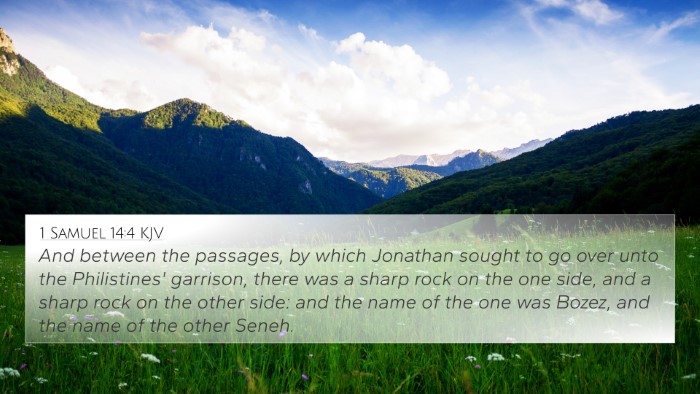Old Testament
Genesis Exodus Leviticus Numbers Deuteronomy Joshua Judges Ruth 1 Samuel 2 Samuel 1 Kings 2 Kings 1 Chronicles 2 Chronicles Ezra Nehemiah Esther Job Psalms Proverbs Ecclesiastes Song of Solomon Isaiah Jeremiah Lamentations Ezekiel Daniel Hosea Joel Amos Obadiah Jonah Micah Nahum Habakkuk Zephaniah Haggai Zechariah MalachiJob 39:28 Similar Verses
Job 39:28 Cross References
She dwelleth and abideth on the rock, upon the crag of the rock, and the strong place.
Uncover the Rich Themes and Topics of This Bible Verse
Listed below are the Bible themes associated with Job 39:28. We invite you to explore each theme to gain deeper insights into the Scriptures.
Job 39:28 Cross Reference Verses
This section features a detailed cross-reference designed to enrich your understanding of the Scriptures. Below, you will find carefully selected verses that echo the themes and teachings related to Job 39:28 KJV. Click on any image to explore detailed analyses of related Bible verses and uncover deeper theological insights.

1 Samuel 14:4 (KJV) »
And between the passages, by which Jonathan sought to go over unto the Philistines' garrison, there was a sharp rock on the one side, and a sharp rock on the other side: and the name of the one was Bozez, and the name of the other Seneh.
Job 39:28 Verse Analysis and Similar Verses
Bible Verse Meaning: Job 39:28
Bible Verse: “The eagle dwells and nests on the rock, and she is known for posing high above the earth.”
Summary of Insights from Public Domain Commentaries
In Job 39:28, God is illustrating the majestic and powerful nature of the eagle, utilizing this imagery to convey deeper spiritual truths. The eagle, described as dwelling on high places, reflects the attributes of strength and independence. This verse serves as a reminder of God's creation and His sovereign control over all creatures.
Matthew Henry's Commentary Insights
Freedom and Authority: Henry points to the eagle's ability to soar to great heights, symbolizing freedom from earthly constraints. The eagle’s nest on the rock signifies stability and security—qualities associated with God’s everlasting protection.
Reflection on Creation: This comparison invites believers to acknowledge God’s intricate design in creation, showcasing His power in creating living beings with unique abilities.
Albert Barnes’ Commentary Insights
Symbol of Divine Superiority: Barnes draws attention to the eagle's position as an emblem of divine superiority, suggesting God's omnipotence that oversees all creation.
Life's High Places: The eagle stands at a vantage point high above, serving as an analogy for the spiritual heights believers can attain through faith.
Adam Clarke’s Commentary Insights
Nature and Wisdom: Clarke emphasizes wisdom derived from observing nature. The eagle's innate qualities prompt a reflection on God’s providential care and the lessons we can learn from every creature’s way of life.
Lessons from the Eagle: The eagle's reproductive and nurturing habits encourage believers to embrace their spiritual responsibilities, teaching the importance of raising young in a secure environment.
Connections to Other Bible Verses
Job 39:28 can be cross-referenced with various other scriptures that provide a richer understanding of its themes.
- Exodus 19:4: “You have seen what I did to the Egyptians, and how I bore you on eagles' wings and brought you to Myself.” - This verse speaks to God's protection and guidance, paralleled with the eagle's nurturing instinct.
- Isaiah 40:31: “But those who wait on the Lord shall renew their strength; they shall mount up with wings like eagles.” - This highlights the uplifting nature of faith similar to the eagle’s soaring ability.
- Proverbs 30:18-19: To contemplate the mysteries of the eagle in the air serves as a poetic illustration of incomprehensible divine wisdom.
- Deuteronomy 32:11: “As an eagle stirs up its nest, hovers over its young, spreading out its wings, taking them up, carrying them on its wings.” - Emphasizes God's parental guidance.
- Psalms 103:5: “Who satisfies your mouth with good things, so that your youth is renewed like the eagle’s.” - Symbolizes rejuvenation and strength.
- Luke 17:37: “Wherever the body is, there the eagles will be gathered together.” - Reflects the eagle’s nature in contexts of judgment and gathering.
- Revelation 12:14: “But the woman was given two wings of a great eagle, that she might fly into the wilderness to her place.” - The eagle's imagery as a symbol of divine escape and refuge.
Thematic Connections
Job 39:28 unveils critical themes of strength, protection, divine providence, and the high calling of believers. The eagle serves not only as a creature of might but as an emblem of God's watchfulness over His creation. As seen through the lenses of diverse scriptures, this theme resonates deeply across both the Old and New Testaments.
- Strength and Sovereignty: Every verse including themes of strength echoes a similar sovereignty held by God over all life.
- Lessons from Nature: Many verses, including those from Proverbs and Job, lead to deeper reflections on creation.
- Protection and Guidance: The parental aspects of God’s nature parallel the eagle’s care for her young, seen in various prophetic and devotional literature.
Using Bible Cross-References
For an effective study of Job 39:28, one might utilize Bible cross-reference tools and Bible concordance resources to explore its connections further. Here are some recommended actions:
- Identify Patterns: Look for repeated themes across scripture—particularly those relating to protection and strength.
- Cross-Reference Bible Study: Engage in specific studies that focus on the comparative analysis between themes in Job and other biblical narratives.
- Investigate Thematic Connections: Identify how other Bible verses encapsulate or reflect the thematic essence found in Job 39:28.
Conclusion: Embracing the Teachings of Job 39:28
In summary, Job 39:28 elegantly intertwines themes of divine oversight and the grandeur of creation, portrayed through the eagle. Understanding this verse not only enriches one's scriptural knowledge but also serves as encouragement in the believer's journey of faith. By utilizing cross-referencing and thematic study methods, believers can find deeper connections to the broader narrative and guidance within Scripture.


